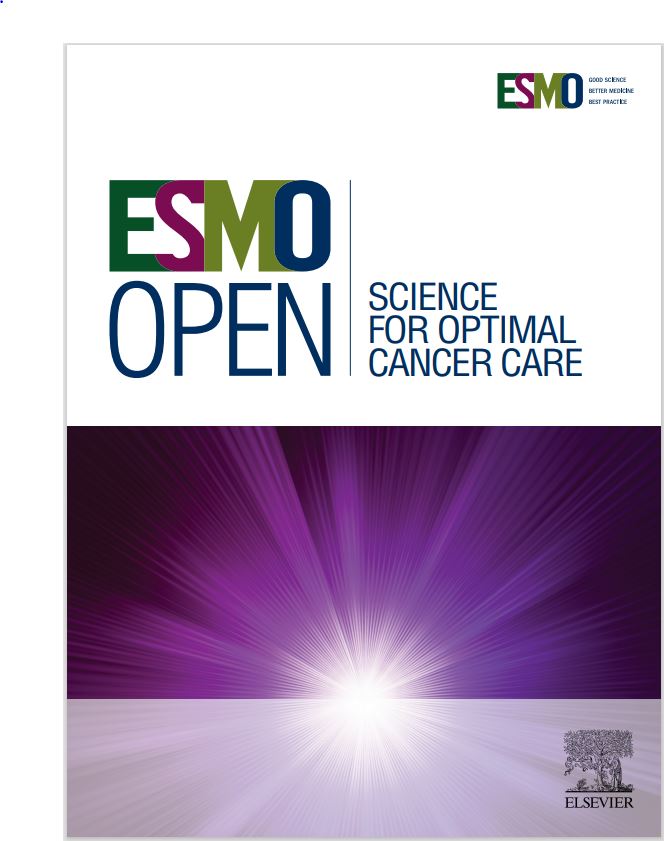小细胞肺癌手术切除原发肿瘤及其淋巴结转移的比较分析
IF 7.1
2区 医学
Q1 ONCOLOGY
引用次数: 0
摘要
背景:小细胞肺癌(SCLC)的谱分析研究主要集中在原发肿瘤上,忽略了淋巴转移形成过程中可能发生的潜在分子变化。在这里,我们根据临床相关蛋白的亚型分布和表达评估了原发性sclc与相应淋巴结(LN)转移之间的分子不一致性。方法采用RNA表达分析和免疫组化(IHC)方法,对32例手术切除的原发性sclc及其LN转移灶进行比较分析。除了亚型标记(ASCL1、NEUROD1、POU2F3和YAP1)外,还评估了9种癌症特异性蛋白的表达。结果选定的临床相关分子在评估原发肿瘤及其相应的淋巴结转移时,其RNA表达谱无显著差异。然而,免疫组化分析显示,DLL3在原发肿瘤中的表达明显高于LN转移瘤(P = 0.008)。相比之下,NEUROD1在原发肿瘤中的表达明显较低(与LN转移相比,P <;0.001)。其他临床相关蛋白的免疫组化分析无统计学差异。在21例SCLC分子亚型中,检测到亚型分布的变化。表型转换从神经内分泌(NE)亚型到非NE病变,从非NE景观到NE亚型都被检测到。结论SCLC LN转移灶的分子格局与原发灶相似,但DLL3和NEUROD1的表达及亚型分布存在关键差异。在为未来的临床试验建立仅基于淋巴结活检的肿瘤分子谱时,应考虑到这些诊断缺陷。本文章由计算机程序翻译,如有差异,请以英文原文为准。
Comparative profiling of surgically resected primary tumors and their lymph node metastases in small-cell lung cancer
Background
Profiling studies in small-cell lung cancer (SCLC) have mainly focused on primary tumors, omitting the potential molecular changes that might occur during lymphatic metastasis formation. Here, we assessed the molecular discordance between primary SCLCs and corresponding lymph node (LN) metastases in the light of subtype distribution and expression of clinically relevant proteins.
Methods
Comparative profiling of 32 surgically resected primary SCLCs and their LN metastases was achieved by RNA expression analysis and immunohistochemistry (IHC). In addition to subtype markers (ASCL1, NEUROD1, POU2F3, and YAP1), the expression of nine cancer-specific proteins was evaluated.
Results
The selected clinically relevant molecules showed no significant differences in their RNA expression profile when assessing the primary tumors and their corresponding LN metastases. Nevertheless, IHC analyses revealed significantly higher DLL3 expression in the primary tumors than in the LN metastases (P = 0.008). In contrast, NEUROD1 expression was significantly lower in the primary tumors (versus LN metastases, P < 0.001). No statistically significant difference was found by IHC analysis in the case of other clinically relevant proteins. Concerning SCLC molecular subtypes, a change in subtype distribution was detected in 21 cases. Phenotype switching from neuroendocrine (NE) subtypes toward non-NE lesions and from non-NE landscape toward NE subtypes were both detected.
Conclusions
Although the molecular landscape of SCLC LN metastases largely resembles that of the tumor of origin, key differences exist in terms of DLL3 and NEUROD1 expression, and in subtype distribution. These diagnostic pitfalls should be considered when establishing the tumors’ molecular profile for future clinical trials solely based on LN biopsies.
求助全文
通过发布文献求助,成功后即可免费获取论文全文。
去求助
来源期刊

ESMO Open
Medicine-Oncology
CiteScore
11.70
自引率
2.70%
发文量
255
审稿时长
10 weeks
期刊介绍:
ESMO Open is the online-only, open access journal of the European Society for Medical Oncology (ESMO). It is a peer-reviewed publication dedicated to sharing high-quality medical research and educational materials from various fields of oncology. The journal specifically focuses on showcasing innovative clinical and translational cancer research.
ESMO Open aims to publish a wide range of research articles covering all aspects of oncology, including experimental studies, translational research, diagnostic advancements, and therapeutic approaches. The content of the journal includes original research articles, insightful reviews, thought-provoking editorials, and correspondence. Moreover, the journal warmly welcomes the submission of phase I trials and meta-analyses. It also showcases reviews from significant ESMO conferences and meetings, as well as publishes important position statements on behalf of ESMO.
Overall, ESMO Open offers a platform for scientists, clinicians, and researchers in the field of oncology to share their valuable insights and contribute to advancing the understanding and treatment of cancer. The journal serves as a source of up-to-date information and fosters collaboration within the oncology community.
 求助内容:
求助内容: 应助结果提醒方式:
应助结果提醒方式:


